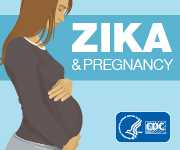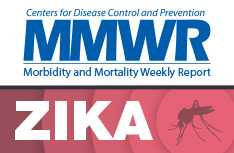Frequently Asked Questions about Updated Interim Guidance for Healthcare Providers Caring for Pregnant Women with Possible Zika Virus Exposure
This page outlines frequently asked questions related to the updated interim guidance for healthcare providers caring for pregnant women with possible Zika virus exposure, published on July 24, 2017.
Rationale for changing guidance
Why are you changing the testing procedure now?
CDC is committed to providing updated information as it becomes available. The updated Zika virus testing guidance for pregnant women incorporates what we’ve learned about Zika virus over the last year and takes into account the overall decline in cases of Zika in the Americas. It also helps to avoid misinterpretation of Zika test results for pregnant women.
The risk of Zika-related abnormalities does not differ by symptom status, so why does CDC not recommend testing?
Similar numbers of infants born to symptomatic and asymptomatic women have been reported to have Zika-associated birth defects. But with declining prevalence of Zika, the probability of false-positive test results increases. In addition, the changing epidemiology further limits the diagnostic capability of currently available Zika virus tests. For this reason, routine testing is no longer recommended because false-positive results could lead to negative repercussions for pregnant women and their care. The limitations of currently available tests and the lack of a vaccine or an effective therapy to prevent congenital infection or mitigate sequelae of Zika virus infection during pregnancy, or in the neonate, underscore the importance of shared patient-provider decision-making. The decision to test for Zika virus should take into account the patient’s unique circumstances and should allow pregnant women to make an informed decision about the usefulness of testing.
If there is enough risk to recommend that pregnant women not travel to any area with risk of Zika, why would you not test all pregnant women if they had possible exposure to these areas?
Although the recommendations related to travel and testing for pregnant women are inherently linked, the rationale behind them is different and they should be thought of separately. The travel guidance is a primary prevention measure. Because of the severe effects of Zika infection during pregnancy, pregnant women should not travel to areas with risk for Zika. If pregnant women must travel to these areas, they should be counseled about the risks of Zika infection, ways to protect themselves, and the limitations of Zika testing upon their return.
The testing guidance provides up-to-date, easy-to-understand information for healthcare providers to diagnose pregnant women with possible Zika virus infection. The testing guidance takes into consideration what has been learned about Zika during the response, testing limitations, and the current epidemiologic status of Zika in the Americas.
Implications for infant guidance
What does this mean for the infant guidance? Will there be an update?
CDC is working with key partners to gain expert input on updates needed for the infant guidance. Specifically, CDC and key partners will assess the need for additional guidance for infants and children in terms of diagnostics and developmental assessments. It is critical that pediatricians ask about potential maternal and congenital Zika exposure for every newborn. For infants born to mothers with possible Zika exposure during pregnancy who were not tested for Zika, healthcare providers should use the same considerations noted above to assess the level of exposure. If healthcare providers decide further evaluation of the newborn is warranted for possible Zika virus infection, a comprehensive physical exam, head ultrasound, and ophthalmologic assessment could be considered.
Implementing updated guidance
How should shared decision-making be implemented?
The updated pregnancy guidance reflects the current transition from a short-term response to a new and unknown congenital infection to the long-term clinical management standards, which incorporate all available evidence. The emphasis is on a shared decision-making model, one in which patients and providers work together to make decisions about testing and care plans based on patient preferences and values, clinical judgment, a balanced assessment of risks and expected outcomes, and the jurisdiction’s recommendations. This model is one that is already used when discussing screening, such as genetic counseling/testing and breast and ovarian cancer screening.
To decide if further evaluation for Zika is warranted, clinicians should consider risk factors unique to their patients, including the level of possible Zika virus exposure and the presence of any clinical findings. Decision-making should be informed by pre-test counseling that clearly conveys the limitations to interpretation of test results and the lack of a vaccine or an effective intervention to prevent congenital infection or mitigate sequelae of Zika virus infection during pregnancy or in the neonate. Patient preferences and values are an essential piece of the decision-making process, including her perception of the personal importance of getting tested and her perception of how test results may inform her clinical care.
CDC has created conversation guides to assist healthcare providers with these conversations.
Do you have tools that HCPs can use to screen for risk factors associated with likelihood of Zika virus infection acquisition?
Yes. To help implement the updated guidance, CDC revised numerous materials, including the algorithm pdfs, the pretest counseling materials, and the tool to evaluate pregnant women to see if testing is indicated. We also prepared a one-page overview to support clinical outreach; this material outlines rationale for the updated guidance, an overview of the changes, implications for pediatric evaluation, and Zika prevention measures. To find these resources, visit CDC’s Print Resources page.
What would make some jurisdictions want to keep testing?
Jurisdictions that have local Zika virus transmission, a large segment of the population with frequent (daily/weekly) exposure through travel, or a higher proportion of infections than expected may decide to continue to test all asymptomatic pregnant women based on local capacity and preferences. Some jurisdictions may choose to align updates to their recommendations with other epidemiologic considerations such as local Zika virus transmission as well as the seasonality and mosquito surveillance and control factors in areas with risk of Zika virus transmission.
Clarifications of updated guidance
Where does sexual transmission fit in the context of ongoing exposure?
Ongoing exposure in the context of CDC guidance refers to a person who lives in an area with risk of Zika or has frequent exposure (e.g., lives on the US-Mexico border with regular travel into Mexico).
For a pregnant woman who has a partner who frequently (e.g., daily, weekly) travels to an area with risk of Zika, we recommend using condoms or abstaining from sex for the duration of the pregnancy. In the event this advice is not followed and there is recurrent unprotected sex, then it would be reasonable to follow the guidance for asymptomatic women with ongoing exposure.
For a pregnant woman who has a partner who traveled once to an area with risk of Zika, we recommend using condoms or abstaining from sex for the duration of the pregnancy. If the recommendations are not followed, this situation possibly could be considered ongoing exposure. However, given the very low likelihood of infection, pretest counseling about the likelihood of false positive results would be very important and clinical judgment on the likelihood of infection in the partner (e.g., type of travel, length of exposure, presence of symptoms, protective measures taken, and intensity of Zika transmission) as well as patient preference should be considered when deciding whether to test.
Asymptomatic pregnant women living in an endemic area fit the criteria for ongoing exposure, but once they relocate to the United States, would one NAT test be recommended?
Testing of asymptomatic pregnant women who relocate to the United States should be considered using a shared decision-making model based on these factors: limitations of the tests; the potential for false positive or false negative results; her perception of the personal importance of getting tested and her perception of how test results may inform her clinical care in the context of the testing limitations; and the lack of a vaccine or an effective intervention to prevent congenital infection or mitigate sequelae of Zika virus infection during pregnancy or in the neonate.
Depending on time elapsed between last exposure and presentation for care, one NAT could be considered in accordance with the recommendations for asymptomatic women with ongoing exposure, but is not routinely recommended for this group. Routine prenatal care, including ultrasound and regular screening for symptoms of Zika, should be encouraged.
The new recommendations only refer to females. Is the guidance for testing males also going to change?
Testing recommendations for men remain the same. Zika virus testing is indicated for non-pregnant women and men who have possible exposure to Zika and who experience symptoms of Zika virus disease. To review the recommendations, visit CDC’s Testing Guidance webpage.
- Page last reviewed: August 14, 2017
- Page last updated: August 14, 2017
- Content source:





 ShareCompartir
ShareCompartir